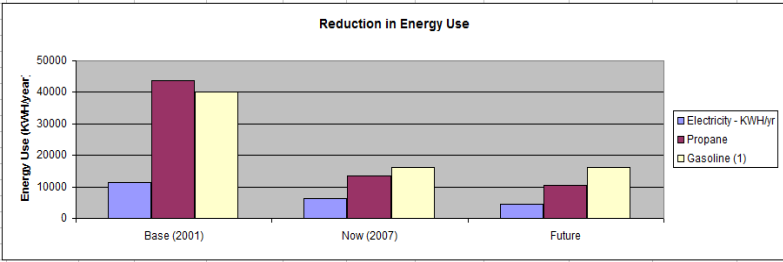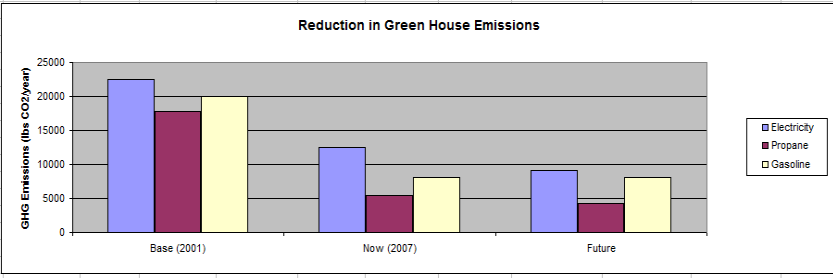
Search
The Renewable Energy site for Do-It-Yourselfers
1/2 -- Lessons and Comments
This is a list of a few things we
noted during the 1/2 process.
|
|
Answers to the initial questions
These were the things we wanted to
find out when we started the 1/2 project:
Can we cut our energy use and green
house gas emissions by 50%?
Yes -- Results To-Date:
(1)
| Reduction in Energy Use |
59,100 KWH/year |
A 63% reduction |
| Green house gas reduction |
36,100 lbs/year |
A 60%reduction |
| Total cost of projects |
$11,725 |
|
| First year saving on energy bills |
$4,830 |
41% first year return |
Projects now in work will result
in some further reductions.
How hard is it?
Not very hard -- see the details
on the projects.
No lifestyle changes needed -- the next 50% might require some lifestyle
changes, which is fine.
What will it cost?
Our total cost to date is
$11,725
This may seem like a lot,
but look at the rate of return (below), and the protection that this buys
against future fuel price increases.
If this seems like more than
you want to bite off, take a look at the
Top
Eight Projects ..
How much money will we save?
Our estimated first year saving is $4830
- this is a first year return of
41%. This will go up over time as fuel prices rise.
(1) The small print:
This includes all energy to run and heat our home and gasoline to run the car.
It does NOT include the energy used to manufacture or transport the things we buy.
Maybe someone has some ideas for these areas?
I think that investing in energy
saving projects is indeed a win-win. You reduce green house gas emissions
(your kids and grand kids will appreciate that), and you earn a very good return
on the dollars you invest.
Prioritizing the Projects
If you want to get the most energy
reduction and green house gas reduction for the dollars you spend, it's
important to make a long list of potential projects, and then try to work
out the cost, energy, and green house gas saving for each. You will
likely find a huge difference in the bang for the buck. In our
case, simple things like controlling the amount of power that our PC's use,
or basic insulating projects paid well. Some easy to implement solar heating
projects are also paying well. On the other end of the spectrum, the solar
PV project we intend to do in the future will cost as much as all our other
projects put together (22 in all), yet will only account 2.5% of the total energy reduction.
Its hard to say which projects will
work well for any given situation, but the types of projects that are likely to
be among the most cost effective in all situations are:
Reducing your use of electricity
Driving a more fuel efficient car (or altering your transportation habits)
Insulating, Infiltration control, and duct sealing
Insulating window treatments
Simple
solar water or space heating projects (and passive cooling)
See the
planning area for ideas on how to make a good list of projects for your
situation.
So, why is
economic payback so good?
When you look at the first year rate
of return for all of the projects completed to date its a whooping 41%.
This return is tax free, and it will likely go up each year as fuel prices go
up. While I expected a descent return, 41% surprised me. After looking
through the projects again, I think this is why the return is high:
-
We evaluated each project for what
it cost and what it saved, and threw out the ones that did not pay well --
this is key -- do a bit of homework before you get started -- see
planning.
-
Some projects cost almost nothing,
but have big savings -- you can see on the project
charts that there are several projects where the first year returns are in
the hundreds of percent. These excellent projects tend to bring up the
average return.
-
We are Do-It-Yourselfers -- this
can make a huge difference on some energy saving projects.
-
We put off the solar PV project to
a little ways into the future. When we do the PV system, it will about
double the total dollars spent, and only add about 2.5% to the energy saving,
so it will cause the average return to go down a fair bit.
Another bonus is that some of
these projects also qualify for rebates or tax credits that
will further improve the 41% return.
You can also further improve the
economic return by doing only the most cost effective projects -- for example,
the Top 8 projects ...
The Hybrid
When I look at our total energy use
picture, I have to say that buying the Hybrid Prius had the biggest impact of
any single change.
The Prius:
-
Cut our personal transportation
energy use and green house gas emissions by 60%
-
Saved us nearly $2000 dollars in
gasoline costs for the year.
-
Was easy to -- no Do-It-Yourself
labor involved.
-
Is a great
car to drive -- no sacrifices.
-
Is proving to be a good investment.
I thought that cutting the automobile
transport portion of our energy use in half was going to the the most difficult
part of our 1/2 project -- instead, it turned out to be the easiest part. Highly
recommended.
Saving Electricity
Cutting down on electric use is
really effective in reducing green house gas. The fact that most of our
electricity comes from inefficient coal plants that burn a high carbon fuel
(coal) makes them put out a A LOT of CO2 for the energy they produce. Most
people will be able to easily find many hundreds of kilowatt hours that can
be saved easily and cheaply with minimal change (for example, putting our 2 PC's
on a power diet saved nearly 1800 KWH per year and 3500 lbs of green house gas!!).
Electricity and Green House Gas
This paragraph applies particularly
to the US where most of electricity is generated in coal plants.
Notice that the projects that save
electric energy reduce green house gas by about 2 lbs of CO2 per 1 KWH of energy
saved. And, projects that save heating fuel reduce green house
gas by about 0.5 lb per 1 KWH of energy saved. So, 1 KWH of electricity is
4 times more "dirty" that 1 KWH of heating fuel. This is because
electricity generation at coal fired plants is inefficient (30 to 35%), and coal has
a high carbon content. The point is that electricity in the US is a very
"dirty" fuel in terms of green house gas emissions.
To me, this argues for doing an
especially aggressive job of trimming your electricity use. It also argues
for not using electricity for things like space heating. Electric heaters
generate about 4 times as much green house gas as a gas heaters for the same
heat output.
We should be shutting down coal
plants -- instead we are on course to build more of them -- many more.
"We now stand at a watershed
moment. An entire generation of obsolete coal-fired power plants built in the
1950s and 1960s needs to be replaced, and U.S. utility companies have
announced their intention of building more than 100 new coal plants over the
next 10 to 15 years. Unless something happens soon to tilt the balance toward
more environmentally benign alternatives, nearly all of those power plants
will use the old-fashioned, intrinsically dirty technology known as pulverized
coal. The largest plants will have generating capacities of around 1,000
megawatts (MW), enough to supply electricity to as many as 900,000 homes. Such
a plant costs close to $1 billion to build and has an operating expectancy of
60 years or longer. Every year of its lifetime, it will spout six million tons
of CO2 into the atmosphere -- about the same as two million cars."
From "How to Clean Coal", Craig
Canine
http://www.nrdc.org/onearth/05fal/coal1.asp
This is an excellent article on the
future of coal in the US.
Another good blog entry on coal:
http://alt-e.blogspot.com/2006/10/clean-coal-or-dirty-coal.html
Here is another way to show what a large role
coal generated electricity plays in the pollution puzzle. Look at the following two charts.
They show my family's energy use and our green house gas emissions. Note
that electricity (blue bar) is a relatively small part of the energy we
use, but that small part contributes the biggest share of green house gas.


This is a little unfair, in that it
assumes all of our electricity is generated in coal plants, and it's not -- but,
it looks like it's the way we are headed.
What's included?
We included the energy used in our
household (propane and electricity) and automobile for transportation. These
are the things that we have direct control over, and can change.
The not (as yet) included items
is the energy used to produce and distribute the products we buy, air travel., and probably a few other
things I haven't thought about. It's not that these things are not
consequential (they are), but we have little direct control over them.
As a former Boeing engineer, I believe its likely that Boeing could
build a jet transport that uses half as much fuel, but I don't think I could
convince them to do it -- maybe all of us could?
Gary 08/04/06, 5/13/07, Nov 13, 2007


